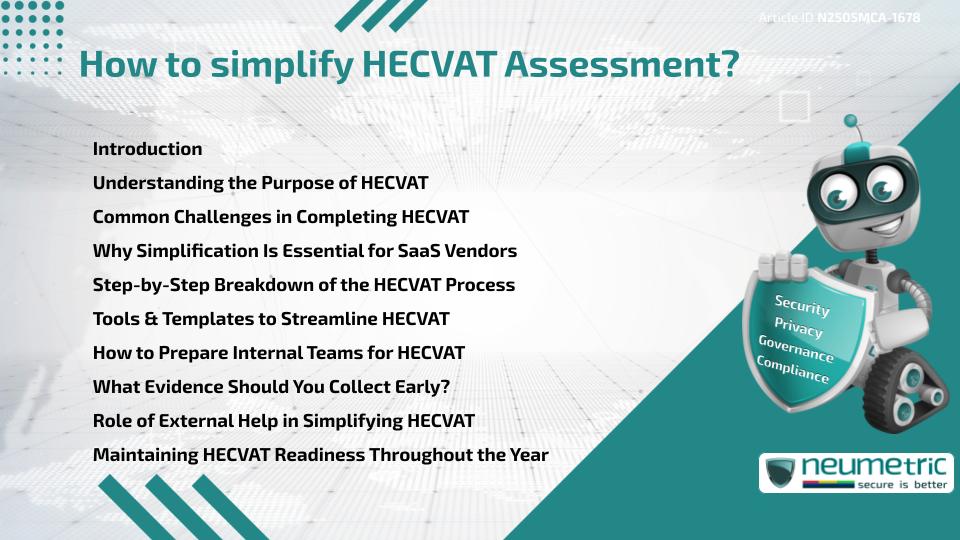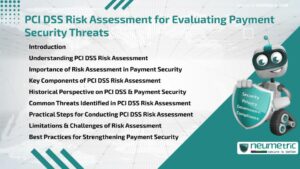Table of Contents
ToggleIntroduction
The Higher Education Community Vendor Assessment Toolkit [HECVAT] is a Standardised Security Questionnaire designed to evaluate the Data & Cybersecurity practices of Cloud Service Providers working with Higher Education Institutions. While its goal is noble to ensure trust, transparency & security the HECVAT process can quickly become overwhelming for SaaS Providers.
So, how to simplify HECVAT Assessment without compromising accuracy or completeness? This article explores practical methods, smart tools & strategic tips to reduce complexity, save time & meet higher education security expectations effectively.
Understanding the Purpose of HECVAT
Before exploring how to simplify HECVAT Assessment, it’s essential to understand why the toolkit exists. HECVAT was developed by EDUCAUSE to help universities assess the Risk posed by Third Party Services. It ensures that Vendors are transparent about their security posture, including Encryption Standards, Data Handling Policies & Breach Response Protocols.
You can find official details about HECVAT’s origins & purpose on EDUCAUSE.
The toolkit comes in multiple versions Full, Lite & On Prem depending on the service & its data sensitivity. Understanding which version applies to your offering helps you avoid unnecessary workload.
Common Challenges in Completing HECVAT
Even experienced teams face difficulty with HECVAT due to:
- Ambiguous or technical questions
- Time consuming documentation
- Unfamiliarity with education sector expectations
- Lack of mapped evidence
If your responses do not align with higher education requirements, it can delay partnerships or create back and forth follow ups. These hurdles often leave Vendors asking how to simplify HECVAT Assessment for everyone involved?
Why Simplification Is Essential for SaaS Vendors
Higher education institutions expect timely, consistent & confident answers. A confusing or delayed HECVAT submission can reflect poorly on your company’s reliability.
Simplification improves:
- Time to complete
- Quality of documentation
- Response alignment
- Internal collaboration
Rather than treating HECVAT as a one time activity, build an efficient & repeatable system. This makes annual reassessments much easier too.
Step by Step Breakdown of the HECVAT Process
To learn how to simplify HECVAT Assessment, break the task into five clear stages:
- Scope your Assessment
Determine which version applies: Full for high Risk data, Lite for lower Risk services. - Review Each Question Group
Categorize questions into what you know, what you need help with & what requires evidence. - Assign Internal Owners
Route Data Protection questions to your Privacy Lead, Encryption questions to your DevOps or Security team. - Centralize Documentation
Store prior assessments, Policies & Third Party Reports (SOC 2, ISO 27001) in one location. - Final Review & Sign Off
Ensure alignment between your technical answers & contractual terms.
Tools & Templates to Streamline HECVAT
Instead of building everything from scratch, use available tools such as:
- HECVAT Excel Templates from EDUCAUSE
- Internal wiki pages for standardised answers
- Collaboration tools like Notion or Confluence
- GRC platforms that automate evidence mapping
Using these resources answers the question how to simplify HECVAT Assessment using reusable content?
How to Prepare Internal Teams for HECVAT
Preparation is half the battle. Introduce HECVAT as part of your regular sales or security enablement plan. Include:
- Short training for Sales & Technical Staff
- Security Documentation playbooks
- Sample past responses to common questions
This preparation helps avoid last minute confusion & reduces repetitive work.
What Evidence Should You Collect Early?
A major part of how to simplify HECVAT Assessment lies in proactive evidence gathering. Recommended artifacts include:
- SOC 2 or ISO 27001 Reports
- Access Control & Encryption Policies
- Backup & Incident Response Procedures
- Third Party Audit Reports
Store these in a shared, version controlled location accessible by relevant teams.
Role of External Help in Simplifying HECVAT
If your internal resources are stretched thin, consider working with consultants who specialize in HECVAT or higher education Compliance. They can:
- Review your responses for alignment
- Provide templates or shortcuts
- Help with technical documentation
While outsourcing is optional, it can be a smart move if you are responding to multiple RFPs simultaneously.
Maintaining HECVAT Readiness Throughout the Year
Simplification doesn’t stop after one submission. Maintain readiness by:
- Reviewing the HECVAT quarterly
- Updating documents after major changes
- Archiving all correspondence with universities
- Conducting internal mock audits
Consistency is key. Use a change log or tracker to monitor updates.
Takeaways
- Understand the toolkit version & scope upfront
- Break HECVAT into manageable stages
- Use tools, templates & wikis for consistency
- Collect Standard evidence early to avoid delays
- Train teams & assign owners to reduce confusion
- Consider external help for large or complex submissions
- Maintain a living repository of responses & artifacts
FAQ
What is the quickest way to respond to a HECVAT Questionnaire?
Use pre-filled templates, standard evidence & assign specific team members to answer recurring questions.
How to simplify HECVAT Assessment if we are a small startup?
Focus on the Lite version, reuse SOC 2 or ISO controls & limit the scope to only what’s applicable.
Do we need to complete all HECVAT sections?
No, only those relevant to your service & Customer requirements. Clarify with the institution before skipping.
Can we use Third Party Audit reports to respond faster?
Yes, Audit reports like SOC 2 or ISO 27001 often map directly to HECVAT questions & can save significant time.
How often should we update our HECVAT responses?
At least once every year or after major product, infrastructure or policy changes.
Is using the Full version mandatory?
Not always. It depends on the sensitivity of the data you handle. The Lite version often suffices for basic services.
Who should lead the HECVAT Assessment internally?
Ideally, someone from your Compliance or security team. For smaller teams, the CTO or Privacy officer may take charge.
How to avoid repetitive work during multiple HECVAT submissions?
Maintain a centralized knowledge base & reuse answers after review & minor customization.
References
Need help?
Neumetric provides organisations the necessary help to achieve their Cybersecurity, Compliance, Governance, Privacy, Certifications & Pentesting goals.
Organisations & Businesses, specifically those which provide SaaS & AI Solutions, usually need a Cybersecurity Partner for meeting & maintaining the ongoing Security & Privacy needs & requirements of their Clients & Customers.
SOC 2, ISO 27001, ISO 42001, NIST, HIPAA, HECVAT, EU GDPR are some of the Frameworks that are served by Fusion – a centralised, automated, AI-enabled SaaS Solution created & managed by Neumetric.
Reach out to us!





